

Refugee Matching Narges Ahani (Worcester Polytechnic Institute) Tommy Andersson (Lund University and Stockholm School of Economics) David Delacretaz (University of Oxford) Will Jones (Royal Holloway University) Scott Duke Kominers (Harvard University) Alessandro Martinello (Lund University) Alexander Teytelboym (University of Oxford) Andrew C. Trapp (Worcester Polytechnic Institute)
Asylum seekers in Sweden, 2002-2018
The first immigrant recorded at Ellis Island in 1892 Annie MOORE (Matching and Outcome Optimization for Refugee Empowerment)
Annie MOORE (the software) • The computer software Annie MOORE answers the following question: where in a country should person A be placed? ?
Key integration factors • ”T here is no single, generally accepted definition, theory or model of immigrant and refugee integration” (Castles et al., 2002) • Examples: employment, housing, education, demography, social networks, health, etc. • We focus on employment in the remaining part of the talk
Employment (time matters)
Employment (macro and micro) • Empirical evidence that initial match between refugee and region matters for employment, welfare and education • Macro vs micro: – Regions have different characteristics (industry structure, employment rates, growth,…) – Refugees have different characteristics (age, gender, education, spoken languages, work experience,…)
Employment (region matters)
Employment (macro and micro) • Empirical evidence that initial match between refugee and region matters for employment, welfare and education • Macro vs micro: – Regions have different characteristics (industry structure, employment rates, growth,…) – Refugees have different characteristics (age, gender, education, spoken languages, work experience,…)
Employment (individual characteristics matter) Person B Person A
The underlying idea • Both macro and micro factors influence the probability for a refugee to get employment • Note also: regional capacities and service provision (schooling, housing, health care ,…) are limited
𝐺 1 𝐺 2 𝐺 3 𝐺 4 𝐺 5 𝑀 1 𝑀 2 𝑀 3 𝑀 4
𝐺 1 𝐺 2 𝐺 3 𝐺 4 𝐺 5 Units of advanced health care needed 𝑀 1 Number of school seats needed 𝑀 2 𝑀 3 𝑀 4
𝐺 1 𝐺 2 𝐺 3 𝐺 4 𝐺 5 Units of advanced health care needed 𝑀 1 Number of school seats needed 𝑀 2 𝑀 3 𝑀 4
𝐺 1 𝐺 2 𝐺 3 𝐺 4 𝐺 5 Units of advanced health care needed 𝑀 1 Number of school seats needed 𝑀 2 𝑀 3 𝑀 4
𝐺 1 𝐺 2 𝐺 3 𝐺 4 𝐺 5 Units of advanced health care needed 𝑀 1 Number of school seats needed 𝑀 2 𝑀 3 𝑀 4
𝐺 1 𝐺 2 𝐺 3 𝐺 4 𝐺 5 Units of advanced health care needed 𝑀 1 Number of school seats needed 𝑀 2 𝑀 3 𝑀 4
Annie MOORE • Annie MOORE integrates machine learning (“ expected probability of employment ”) and integer optimization techniques (“ service provision ”) into an innovative software tool that assists agencies with matching refugees to their initial placements
Sweden vs USA • Before Alex starts talking, note that: – We don’t have data for Sweden (i.e., we will not be able to say anything about Sweden) – We only discuss refugees resettled by HIAS in the US – Huge differences between US and Sweden: • More flexible labour markets in the US • Different legislation (e.g., EBO in Sweden) • Different welfare systems • Etc.
Recommend
More recommend